2017 KIA Soul EV tire pressure
[x] Cancel search: tire pressurePage 364 of 470
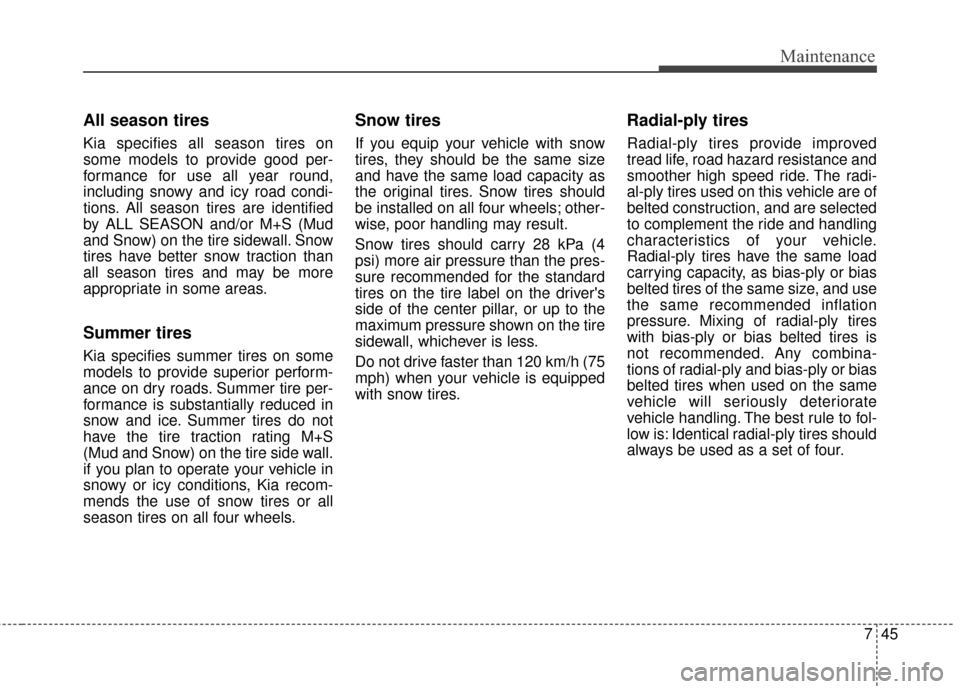
745
Maintenance
All season tires
Kia specifies all season tires on
some models to provide good per-
formance for use all year round,
including snowy and icy road condi-
tions. All season tires are identified
by ALL SEASON and/or M+S (Mud
and Snow) on the tire sidewall. Snow
tires have better snow traction than
all season tires and may be more
appropriate in some areas.
Summer tires
Kia specifies summer tires on some
models to provide superior perform-
ance on dry roads. Summer tire per-
formance is substantially reduced in
snow and ice. Summer tires do not
have the tire traction rating M+S
(Mud and Snow) on the tire side wall.
if you plan to operate your vehicle in
snowy or icy conditions, Kia recom-
mends the use of snow tires or all
season tires on all four wheels.
Snow tires
If you equip your vehicle with snow
tires, they should be the same size
and have the same load capacity as
the original tires. Snow tires should
be installed on all four wheels; other-
wise, poor handling may result.
Snow tires should carry 28 kPa (4
psi) more air pressure than the pres-
sure recommended for the standard
tires on the tire label on the driver's
side of the center pillar, or up to the
maximum pressure shown on the tire
sidewall, whichever is less.
Do not drive faster than 120 km/h (75
mph) when your vehicle is equipped
with snow tires.
Radial-ply tires
Radial-ply tires provide improved
tread life, road hazard resistance and
smoother high speed ride. The radi-
al-ply tires used on this vehicle are of
belted construction, and are selected
to complement the ride and handling
characteristics of your vehicle.
Radial-ply tires have the same load
carrying capacity, as bias-ply or bias
belted tires of the same size, and use
the same recommended inflation
pressure. Mixing of radial-ply tires
with bias-ply or bias belted tires is
not recommended. Any combina-
tions of radial-ply and bias-ply or bias
belted tires when used on the same
vehicle will seriously deteriorate
vehicle handling. The best rule to fol-
low is: Identical radial-ply tires should
always be used as a set of four.
Page 365 of 470
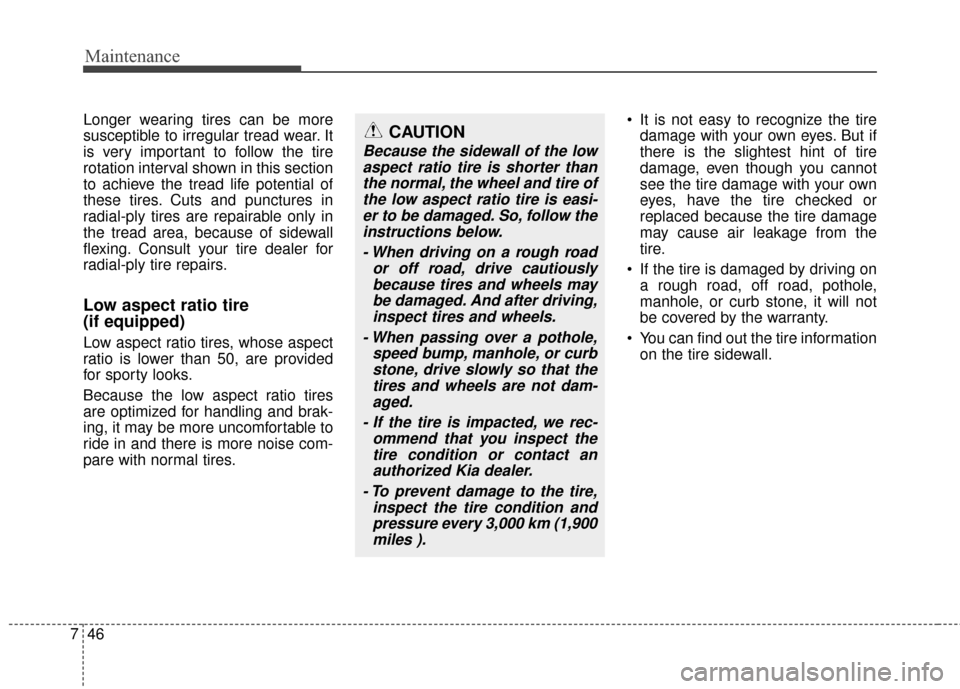
Maintenance
46
7
Longer wearing tires can be more
susceptible to irregular tread wear. It
is very important to follow the tire
rotation interval shown in this section
to achieve the tread life potential of
these tires. Cuts and punctures in
radial-ply tires are repairable only in
the tread area, because of sidewall
flexing. Consult your tire dealer for
radial-ply tire repairs.
Low aspect ratio tire
(if equipped)
Low aspect ratio tires, whose aspect
ratio is lower than 50, are provided
for sporty looks.
Because the low aspect ratio tires
are optimized for handling and brak-
ing, it may be more uncomfortable to
ride in and there is more noise com-
pare with normal tires. It is not easy to recognize the tire
damage with your own eyes. But if
there is the slightest hint of tire
damage, even though you cannot
see the tire damage with your own
eyes, have the tire checked or
replaced because the tire damage
may cause air leakage from the
tire.
If the tire is damaged by driving on a rough road, off road, pothole,
manhole, or curb stone, it will not
be covered by the warranty.
You can find out the tire information on the tire sidewall.
CAUTION
Because the sidewall of the lowaspect ratio tire is shorter thanthe normal, the wheel and tire ofthe low aspect ratio tire is easi-er to be damaged. So, follow theinstructions below.
- When driving on a rough road or off road, drive cautiouslybecause tires and wheels maybe damaged. And after driving,inspect tires and wheels.
- When passing over a pothole, speed bump, manhole, or curbstone, drive slowly so that thetires and wheels are not dam-aged.
- If the tire is impacted, we rec- ommend that you inspect thetire condition or contact anauthorized Kia dealer.
- To prevent damage to the tire, inspect the tire condition andpressure every 3,000 km (1,900miles ).
Page 373 of 470

Maintenance
54
7
Fuse Name Fuse rating Circuit Protected
MODULE 1 10A BCM IBAU 10A Integrated Brake Actuation Unit
MODULE 2 10A Tire Pressure Monitoring Module, Crash Pad Switch, Center Fascia Switch, Electronic Parking Brake
Module, Stop Lamp Switch, Rear Parking Assist Sensor RH/LH (IN/OUT), Front Parking Assit Sensor
LH/RH (OUT/IN)
MODULE 3 10A ATM Lever Indicator, Multipurpose Check Connector, PCB Block (IG3 #4 Relay) PDM 3 7.5A Smart Key Control Module
IOD 2 15A A/V & Navigation Head Unit
IOD 3 7.5A ICM Relay Box (Outside Mirror Folding Relay, Outside Mirror Unfolding Relay)
CLUSTER 10A Instrument Cluster IG1 15A EPCU
IOD 4 7.5A Instrument Cluster, Tire Pressure Monitoring Module, Data Link Connector, Multipurpose Check Connector,
A/C Control Module, BCM
FOG LAMP REAR 10A Rear Fog Lamp Control Block SUNROOF 2 20A SUNROOF_MOTOR (POWER)
SUNROOF 1 20A SUNROOF_MOTOR (POWER) MDPS 7.5A MDPS Unit
START 7.5A Transaxle Range Switch
IOD 1 7.5A Overhead Console Lamp, Vanity Lamp LH/RH, Room Lamp, Glove Box Lamp, Luggage Lamp
PDM 2 7.5A Smart Key Control Module
PDM 1 20A Smart Key Control Module
BRAKE SWITCH 10A Smart Key Control Module, Stop Lamp Switch
Page 395 of 470
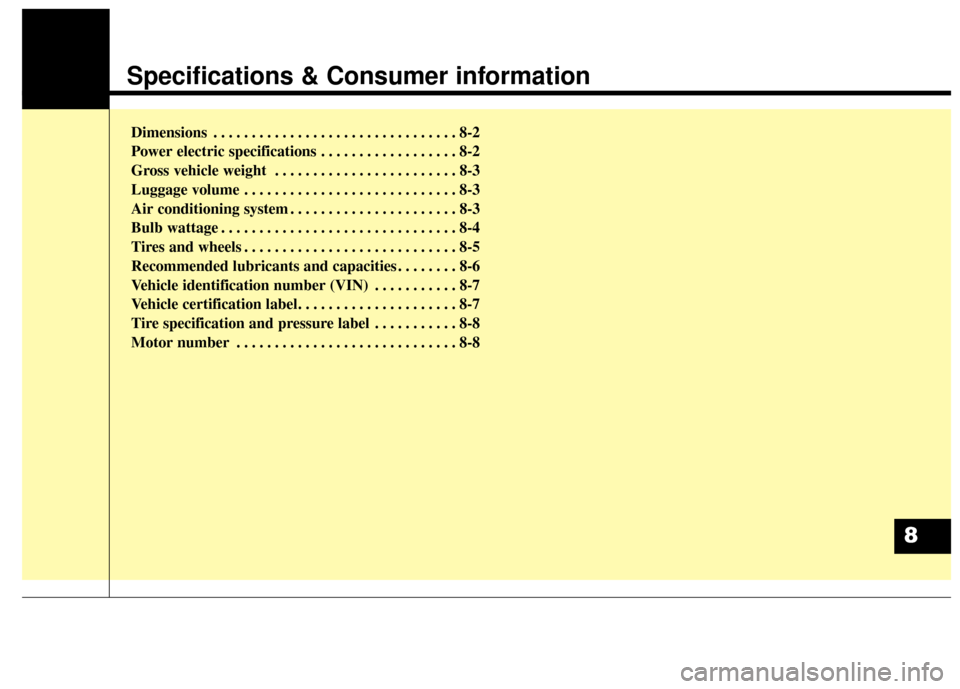
Specifications & Consumer information
Dimensions . . . . . . . . . . . . . . . . . . . . . . . . . . . . . . . . 8-2
Power electric specifications . . . . . . . . . . . . . . . . . . 8-2
Gross vehicle weight . . . . . . . . . . . . . . . . . . . . . . . . 8-3
Luggage volume . . . . . . . . . . . . . . . . . . . . . . . . . . . . 8-3
Air conditioning system . . . . . . . . . . . . . . . . . . . . . . 8-3
Bulb wattage . . . . . . . . . . . . . . . . . . . . . . . . . . . . . . . 8-4
Tires and wheels . . . . . . . . . . . . . . . . . . . . . . . . . . . . 8-5
Recommended lubricants and capacities . . . . . . . . 8-6
Vehicle identification number (VIN) . . . . . . . . . . . 8-7
Vehicle certification label. . . . . . . . . . . . . . . . . . . . . 8-7
Tire specification and pressure label . . . . . . . . . . . 8-8
Motor number . . . . . . . . . . . . . . . . . . . . . . . . . . . . . 8-8
8
Page 399 of 470

85
Specifications & Consumer information
TIRES AND WHEELS
*1: Load Index
*2: Speed Symbol
ItemTire sizeWheel sizeLoad CapacitySpeed capacityInflation pressure kPa (psi)Wheel lug nut torque
kgf•m (lbf N
Normal loadMaximum load
LI *1KgSS *2Km/hFrontRear FrontRear
Full size tire205/60R166.5J×1692630H210230 (33)9~11
(65~79, 88~107)
CAUTION
When replacing tires, use the same size originally supplied with the vehicle.
Using tires of a different size can damage the related parts or make it work irregularly.
✽ ✽ NOTICE
• We recommend that when replacing tires, use the same originally supplied with the vehicles. If not, that aff\
ects driving
performance.
• When driving in high altitude grades, it is natural for the atmospheric pressure to decrease. Therefore, please check the tire pressure and add more air when necessary.
Additionally required tire air pressure per km above sea level: 10 kPa/km (1.5 lb/po²/km).
Page 402 of 470
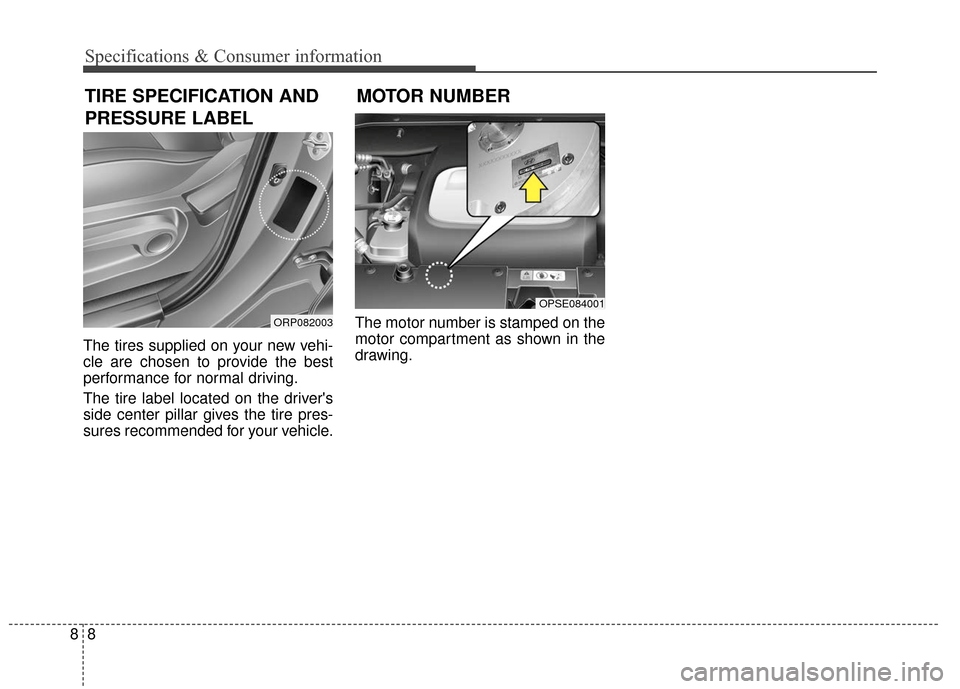
Specifications & Consumer information
88
The tires supplied on your new vehi-
cle are chosen to provide the best
performance for normal driving.
The tire label located on the driver's
side center pillar gives the tire pres-
sures recommended for your vehicle.The motor number is stamped on the
motor compartment as shown in the
drawing.
TIRE SPECIFICATION AND
PRESSURE LABEL
ORP082003
OPSE084001
MOTOR NUMBER
Page 409 of 470
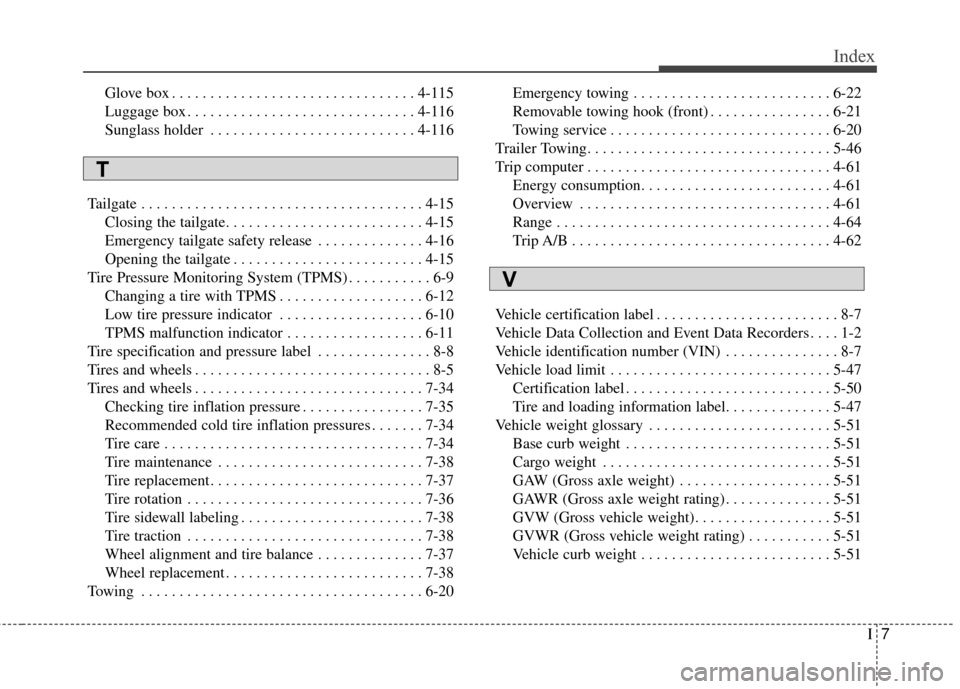
I7
Index
Glove box . . . . . . . . . . . . . . . . . . . . . . . . . . . . . . . . 4-115
Luggage box . . . . . . . . . . . . . . . . . . . . . . . . . . . . . . 4-116
Sunglass holder . . . . . . . . . . . . . . . . . . . . . . . . . . . 4-116
Tailgate . . . . . . . . . . . . . . . . . . . . . . . . . . . . . . . . . . . . \
. 4-15 Closing the tailgate. . . . . . . . . . . . . . . . . . . . . . . . . . 4-15
Emergency tailgate safety release . . . . . . . . . . . . . . 4-16
Opening the tailgate . . . . . . . . . . . . . . . . . . . . . . . . . 4-15
Tire Pressure Monitoring System (TPMS) . . . . . . . . . . . 6-9 Changing a tire with TPMS . . . . . . . . . . . . . . . . . . . 6-12
Low tire pressure indicator . . . . . . . . . . . . . . . . . . . 6-10
TPMS malfunction indicator . . . . . . . . . . . . . . . . . . 6-11
Tire specification and pressure label . . . . . . . . . . . . . . . 8-8
Tires and wheels . . . . . . . . . . . . . . . . . . . . . . . . . . . . . . . 8-5
Tires and wheels . . . . . . . . . . . . . . . . . . . . . . . . . . . . . . 7-34 Checking tire inflation pressure . . . . . . . . . . . . . . . . 7-35
Recommended cold tire inflation pressures . . . . . . . 7-34
Tire care . . . . . . . . . . . . . . . . . . . . . . . . . . . . . . . . . . 7-34\
Tire maintenance . . . . . . . . . . . . . . . . . . . . . . . . . . . 7-38
Tire replacement . . . . . . . . . . . . . . . . . . . . . . . . . . . . 7-37
Tire rotation . . . . . . . . . . . . . . . . . . . . . . . . . . . . . . . 7-36
Tire sidewall labeling . . . . . . . . . . . . . . . . . . . . . . . . 7-38
Tire traction . . . . . . . . . . . . . . . . . . . . . . . . . . . . . . . 7-38
Wheel alignment and tire balance . . . . . . . . . . . . . . 7-37
Wheel replacement . . . . . . . . . . . . . . . . . . . . . . . . . . 7-38
Towing . . . . . . . . . . . . . . . . . . . . . . . . . . . . . . . . . . . . \
. 6-20 Emergency towing . . . . . . . . . . . . . . . . . . . . . . . . . . 6-22
Removable towing hook (front) . . . . . . . . . . . . . . . . 6-21
Towing service . . . . . . . . . . . . . . . . . . . . . . . . . . . . . 6-20
Trailer Towing. . . . . . . . . . . . . . . . . . . . . . . . . . . . . . . . 5-46
Trip computer . . . . . . . . . . . . . . . . . . . . . . . . . . . . . . . . 4-61 Energy consumption. . . . . . . . . . . . . . . . . . . . . . . . . 4-61
Overview . . . . . . . . . . . . . . . . . . . . . . . . . . . . . . . . . 4-61
Range . . . . . . . . . . . . . . . . . . . . . . . . . . . . . . . . . . . . \
4-64
Trip A/B . . . . . . . . . . . . . . . . . . . . . . . . . . . . . . . . . . 4-62\
Vehicle certification label . . . . . . . . . . . . . . . . . . . . . . . . 8-7
Vehicle Data Collection and Event Data Recorders . . . . 1-2
Vehicle identification number (VIN) . . . . . . . . . . . . . . . 8-7
Vehicle load limit . . . . . . . . . . . . . . . . . . . . . . . . . . . . . 5-47 Certification label . . . . . . . . . . . . . . . . . . . . . . . . . . . 5-50
Tire and loading information label. . . . . . . . . . . . . . 5-47
Vehicle weight glossary . . . . . . . . . . . . . . . . . . . . . . . . 5-51 Base curb weight . . . . . . . . . . . . . . . . . . . . . . . . . . . 5-51
Cargo weight . . . . . . . . . . . . . . . . . . . . . . . . . . . . . . 5-51
GAW (Gross axle weight) . . . . . . . . . . . . . . . . . . . . 5-51
GAWR (Gross axle weight rating) . . . . . . . . . . . . . . 5-51
GVW (Gross vehicle weight). . . . . . . . . . . . . . . . . . 5-51
GVWR (Gross vehicle weight rating) . . . . . . . . . . . 5-51
Vehicle curb weight . . . . . . . . . . . . . . . . . . . . . . . . . 5-51
V
T
Page 458 of 470

48
If you operate the air conditioner/heater too much, the driving battery
uses too much electricity. This may
reduce the distance to empty.
Therefore, it is recommended that
you set the cabin temperature to
(23°C (73°F)) AUTO. This setting
that has been certified by various
assessment tests to maintain opti-
mal energy consumption rates while
keeping the temperature fresh.
Turn OFF the heater and air con-
ditioner if you do not need them.
Press and hold the accelerator pedal to maintain speed and drive
economically.
Gradually press and release the accelerator pedal when accelerat-
ing or decelerating.
Always maintain specified tire pressures.
Do not use unnecessary electrical components while driving.
Do not load unnecessary items in the vehicle trunk.
Do not mount parts that may increase air resistance. It shows the energy consumption
rate of the vehicle and the
charge/discharge status of the
regenerative brakes.
POWER : It shows the energy
consumption rate of the vehicle
when driving uphill or accelerat-
ing. The more electric energy is
used, the higher the gauge level.
ECO GUIDE : It shows the energy
consumption rate during normal
driving condition.
CHARGE : It shows the charging
status of the battery when it is
being charged by the regenerative
brakes (decelerating or driving on
a downhill road). The more electric
energy is charged, the lower the
gauge level.
Motor Operation Gauge
DRIVING ELECTRIC VEHICLE
OPSE044302
Tips for Improving Distance
to Empty